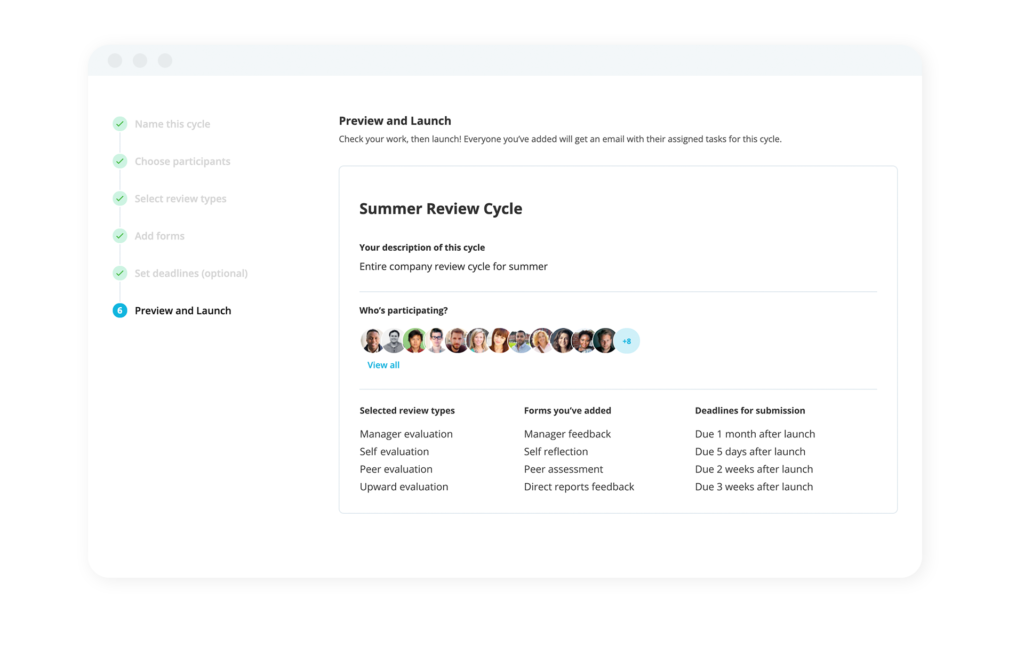Competency Management: Definition & Best Practices
Does the secret to your organisation’s success lie in competency management? Maybe! For good reason, competency management can help give your team a leg-up on your competition, boost productivity and hit your goals. Here’s how it works…
Start from the top with our performance review template today.What is Competency Management?
Competency management is the process of identifying key skills (competencies) required for employees to help hit a business’ goals and long-term objectives. The process of competency management has four key elements:
Identifying the skills needed to achieve goals
Identifying current skills within your workforce
Crafting a roadmap to develop employees from point A to point B
Implementing and iterating on that plan
The Benefits of Competency Management
There are multiple benefits to having a competency management process in your organisation. Here are just a few of them:
Training and development: As you create a competency model, your HR team will learn what skills, behaviours and values they need to instil in their employees. This will help provide direction when developing training and development programmes.
Organisational success: Once you’ve identified the most important competencies for your employees to have, you will start working on developing those competencies. This will result in organisational success since employees will be more productive in what they do.
Core business operations: When you know what competencies you need in the workplace to do your core business, you can create training programmes so that all your employees have the skills to do them. Since your core business operations are unlikely to change immediately, you can reuse these programmes for years.
Streamlined onboarding process: When you hire a new employee, you will know what kind of training they will need to go through in the onboarding process. You will simply look into your competency model and identify what training the new employee needs to go through to develop the competencies to do their job successfully.
Growth opportunities:Gallup stated that 87% of millennials consider growth opportunities as important in their job. With competency management, you will show your employees that you’re investing in them and providing growth opportunities for them. This will help you retain many employees who will stick around the organisation because they’ll feel like they’re growing and that their employers care about their learning and development.
Mentorship and coaching programmes: The HR team doesn’t need to be the only one that implements competency training in your organisation. You can use senior employees as mentors and educators who will teach and guide the new employees through the process. If Google is doing it with their Googler-to-Googler programme, you should also check it out.
Best Practices to Optimise Your Competency Management
There are many great examples when it comes to competency management:
Have all of your employees work in core business for some time:Zappos, a successful Las Vegas-based company, has all of its employees work on their core business operations for two weeks so that they learn what their business is all about. So, no matter your position, you will have to work for two weeks on the phone in customer service.
Assigned buddy: When you’re hiring a new employee, you should integrate them as best and as fast as possible into your environment. To do so, you can use a buddy system, where one of the older employees will guide the candidate through the company and show them around. Or you can use the “TINYpulse approach,” where they pop a bottle of champagne on the new employee’s first day and have a party so that everyone can get to know their new colleague.
A mix of internal and external sources. Once you’ve created a competency model, you don’t need to do all of the training internally. You can provide your employees with the opportunities to attend development sessions from external (pre-vetted) sources. Randstad is one of the largest staffing organisations in the U.S. They provide their employees with the opportunity to develop new managerial, communication and presentation skills from a variety of sources.
Give Potential Room To Grow With Personio

Automate your performance cycles to open up time for job enrichment with Personio today.
Find Out More
Competency Management: Frequently Asked Questions
What is Competency Management?
Competency management is the process of identifying key skills (competencies) required for employees to help hit a business’ goals and long-term objectives.
What are the Benefits of Competency Management?
The benefits of competency management are optimising training and development needs, building organisational success, enhancing core business operations, enjoying streamlined onboarding processes and enabling growth opportunities with mentorship and coaching programmes.
What are Best Practices for Competency Management?
Three best practices for competency management are having your employees work in core business, assigning a buddy during onboarding and providing internal and external resources for development.
Help Build A Stronger Employee L&D Program
Competency management can be a key pillar of your organisation’s learning and development programmes. You will need to know what kind of skills your employees need to do their tasks successfully and a competency model will help you with that.
If you need to collect more information about competency management, we suggest you read our other article: Creating a Skills Matrix: Step-By-Step Guide and Free Template.
